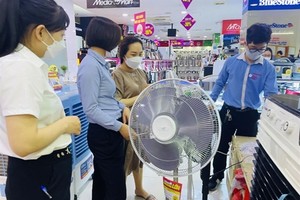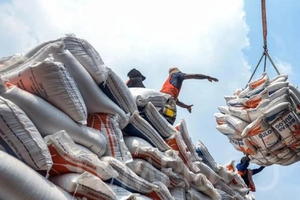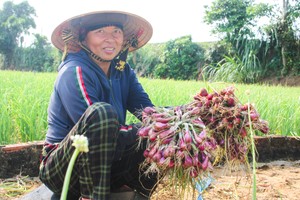With the pandemic gradually coming under control again, businesses are once again reopening, and picking up pace to return back to normal, although year-end revenue will still miss the original target.
Decline in seafood exports
 Illustrative photo
Illustrative photo
In the first half of July 2021, seafood exports saw a growth rate of 16%, while in the second half of July, export turnover decreased significantly, when Ho Chi Minh City and Southern provinces implemented social distancing measures under Directive 16. As a result, seafood export turnover for the whole month decreased by 4% compared to the same period last year.
At that time, according to statistics of the Vietnam Association of Seafood Exporters and Producers (VASEP), about 30% of seafood enterprises in the Southern provinces could ensure the ‘three-on-site’ model plan for workers. With factories that could, the number of workers that could be mobilized were only 30% to 50%, while the remaining workers either had to quit or go on unpaid leave. The average production capacity was reduced to only 40% to 50%, compared to before. It is estimated that the overall capacity on the whole decreased by 30% to 40%.
Meanwhile, fisheries material mobilized for processing exports only reached about 40% to 50% compared to external sources, due to the implementation of social distancing. In addition, businesses are now burdened with rising costs from Covid prevention measures, such as offering workers to adapt to the ‘three-on-site’ model work plan, pay extra wages, and week testing costs, while input and logistics costs continue to increase sharply.
In August, seafood export turnover continued to decline sharply by 36% over the same period last year. This clearly reflects the extent of the negative impact caused by the pandemic on the entire seafood industry. Particularly in August, exports to all markets decreased from 16% to 50% over the same period. In September, exports continued to decline due to production disruptions, while export turnover decreased by 31% over the same period. From October 11, when the Government issued Resolution 128 for safe, flexible adaptation and effective control of the Covid-19 pandemic, businesses gradually began to return back to normal. However, seafood enterprises, especially those in Western provinces, are still faced with many concerns.
Mr. Ho Quoc Luc, Chairman of Board of Directors of Sao Ta Food Joint Stock Company, said that although businesses are returning back to normal, they all have to deal with innumerable difficulties as they start to reopen. The reason for concern lies in the fact that during the last few weeks, new Covid infections and outbreaks have once again quickly increased in the Western provinces, putting too much pressure on frontline workers for pandemic prevention in general, and on businesses in particular, while the vaccination rate in the Western provinces is still low compared to the whole country. This makes costs for enterprises continue to increase. The seafood industry is under great pressure and costs a lot, but it is difficult for the seafood industry to accelerate exports in the last months of the year, even though the year-end consumption demand of many major import markets has increased due to the oncoming holidays.
Mr. Truong Dinh Hoe, General Secretary of VASEP, emphasized that in November, Vietnam would finish shipping consumables for the last season of the year. The last month of 2021 will still see exports, but most import partners are preparing for the first period of 2022, and so the demand is not great. It is forecast that in 2021, the export turnover of the whole industry will only reach US$8.4 bn, missing the initial target of $8.8 bn. Although shrimp exports in 2021 increased slightly by 3%, it was not enough to meet the overall target of the industry.
In fact, seafood is not only facing difficulties due to the Covid-19 pandemic, but also due to many other factors, such as the IUU control mechanism, so exporting to the EU is still facing difficulties. In addition, importing raw materials is also facing many pressures, and the sharp increase in sea freight rates has caused a huge burden for many enterprises.
Drop in exports
Speaking with Saigon Investment, Ms. Phan Thi Thanh Xuan, Vice President of the Vietnam Leather, Footwear and Handbag Association, said that from the beginning of October, enterprises in the export industry have gradually returned back to production. Labor has also returned to factories, and capacity is also gradually increasing to meet demands for year-end season.
However, businesses are still facing many difficulties. Firstly, the requirements for pandemic prevention and control in localities are all different, and the cost of pandemic prevention and control is not small either. Secondly, the input costs such as import of raw materials currently is increasing, because China is also facing much fluctuation in costs due to the pandemic, while logistics costs are causing umpteen headaches for businesses. In addition, the price of gasoline, which is currently on the rise, will also create more burden for businesses in the near future.
Input costs have increased sharply while processing prices remain almost unchanged because the economies of other countries have also been affected by the pandemic, and consumer buying has not increased strongly. It is forecast that by the end of this year, the export turnover of the leather, footwear, and handbag industry will only be equal to that of 2020. Although businesses face many difficulties, their ability to access support packages is very limited due to cumbersome procedures. Currently, most businesses have to be proactive and flexible in all situations.
The reason that the leather, footwear, and handbag industry is also heavily affected by the pandemic is that more than 75% of enterprises in the industry are located in the Southern provinces, which have been the hardest hit during the fourth wave of the covid-19 pandemic.
During the social distancing phase, more than 80% of enterprises in the industry had to stop production altogether, because they could not meet the requirements of ‘three-on-site’ model production plan. A few enterprises in the North were also affected by the high cost of import raw materials from the South, so productivity also decreased. This caused the export turnover in August and September to decrease significantly. Specifically, the export of leather, footwear and handbags in August was severely affected, with export turnover of only $1 bn, down 38.2% over the same period last year. In which, footwear reached $850 mn, down 38.5%, and handbags reached $150 mn, down 37.9%.
Until September, the downward trend had not stopped. According to data from the Vietnam Leather, Footwear and Handbag Association, footwear exports only reached about $700 mn, down more than 44% over the same period in 2020. Meanwhile, handbag exports also fell by 48%, making the total turnover of the whole export industry in September to decrease by nearly 24% over the same period. The association also said that from the end of September the situation has improved, but the reopening of production units under the new normal conditions will take many months to recover to the level it was before the Covid-19 pandemic.
Textiles face backlog
According to statistics, in the first half of October this year, Vietnam's textile and garment export turnover has gradually recovered when reaching a figure of about $1.2 bn. Enterprises are quickly catching up again and speeding up the completion process for orders for the year-end shopping season. However, with the initial export plan of $39 bn for the whole year, the garment industry can hardly keep up and complete the orders. It is expected that Vietnam's textile and garment industry will reach the target of $35 to 36 bn.
Looking back at the year for the textile industry, the first two quarters of the year were full of positive growth. In particular, in the first quarter, the textile and garment industry saw many good signs when most businesses signed orders until the end of the third quarter, even the end of 2021, due to many big markets such as the US, EU, and China loosening on social distancing, and increasing the demand for consumer goods.
In the second quarter, the pandemic broke out in many Northern provinces, especially in Bac Giang and Bac Ninh. However, due to good control measures implemented effectively to contain the disease, the impact was not too great. In the first six months of the year, textile and garment exports continued to increase by 22% compared to the same period in 2020, and by over 5% compared to 2019.
Since the third quarter, when the pandemic broke out in Ho Chi Minh City and the Southern provinces, the garment industry, as well as other labor-intensive industries, have faced many difficulties. About 25% to 30% of textile and garment enterprises in the South still maintain their operations under the ‘three-on-site’ model or ‘one-route-two destinations’ model. During the pandemic, productivity dropped sharply, and supply chains were severely disrupted because many enterprises suspended production. The consequences for the garment industry was a decline in exports. Accordingly, August exports decreased by 15.9% compared to July, and by 2.63% over the same period last year. September exports reached $3 bn, to decrease by 9.2% compared to August, and by 10.5% over the same period.
Mr. Pham Xuan Hong, Chairman of the Ho Chi Minh City Textile and Garment Embroidery Association, said that most enterprises have returned back to production relatively well, but the pressure on safety is quite heavy when some workers still test positive for Covid-19 in some factories, even after they have had two vaccinations. The cost of returning to production is not small, especially with the added cost of Covid-19 pandemic prevention and control measures in enterprises. According to Mr. Hong, when the price of gasoline and oil continues to increase, many businesses are affected because of a high probability that these costs will continue to increase. This will create more difficulties in the recovery process for all enterprises.
























